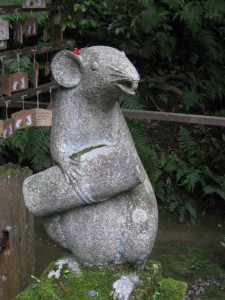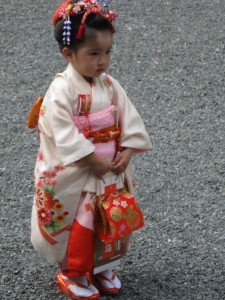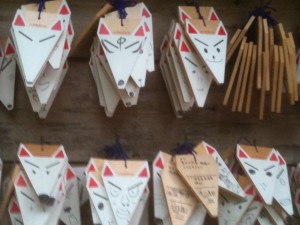
Shrine guardian at the Daikoku-sha in Kyoto's Otoyo Jinja
Cuteness is highly treasured in Japan. ‘Kawaii,’ is one of the country’s catch-phrases, along with gaman (endurance), gambatte (do your best) and shikata ga nai (it can’t be helped). You come across cuteness in daily life, on tv, and in the big-eyed characters of anime and manga. Koala and panda bears are national favourites. Children’s literature is loved for its cute figures like Winnie the Pooh and Beatrix Potter animals.
One day I happened to pass a police-box with a long line of cute little dolls lined up in the front window. From a Western viewpoint it was such an odd juxtapositiion that it set me thinking about the cultural roots of the phenomenon. Could not the cult of cuteness be linked with innocence and a pure heart? And were these not Shinto traits?

An early celebrant of 7-5-3
Sincerity (makoto) is a key Shinto virtue. Doing your best with a pure heart is a key Shinto ethic. The traits go hand in hand with innocence, and the lack of cynicism and irony in Japanese culture has been often noted. That Japanese are innocents abroad, easily duped and deceived, became such a global phenomenon in the 1980s that the foreign ministry ran campaigns about how to prepare for travel abroad in order to avoid being robbed or ripped off.
It’s a cultural trait that can be traced back to the dawn of history and Japan’s earliest writings. In the Manyoshu verse collection, some of which dates back to the fifth and sixth centuries, expression is given to the thinking of the times. ‘Genuineness of thought and feeling pervades all the Manyo poems,’ writes Seiichi Taki, ‘with scarcely any trace of vanity or frivolity.’
By contrast, the Western tradition has been to guard against childlike naivity. ‘Grow up!’ is a common admonition, and children are encouraged to develop an adult sense of distance and cynicism. Cuteness equals childishness, we’re taught, and while a childlike attitude is fine for little children, it’s ridiculous or embarrassing in adults. You don’t find Western women dressed as Bo-Peep or wearing Mickey Mouse socks.

Ema prayer requests at Fushimi Inari
Doi Takeo has written of the tendency to emotional dependency of the Japanese (amaeru), due to overmothering. It results in a tendency to evade the responsibilities of adulthood, and General MacArthur, ungraciously, once described the Japanese as a nation of ‘twelve-year olds’. For Westerners it’s a stunning insult, yet it’s worth noting that twelve-year olds have an innocence which Jesus and others found closer to heaven than the cynicism of adults.
In the Shinto view of life, humans are the children of the kami. Does that encourage childlike qualities? I think the striving for a pure heart might well have something to do with it…
D.T. Suzuki famously claimed that an understanding of Zen was necessary to an understanding of the Japanese, but I’d like to take him up on that because it’s my belief that Shinto is even more fundamental. This is the first of a series of articles by which I hope to prove my point.
(See also Of Innocence and Cynicism)
Fushimi fox guardian, well wrapped against the cold

Interesting blog post. It is the first time I read about Japanese かわいい culture as rooted in Shinto. The important Japanese value to ‘do your best with a pure heart’, seems like a very good explanation why the Japanese love things that appear cute and innocent. Even the way Japanese women dress tends to be more cute than sexy, which is more common in other countries.
I’m going to write an assignment on what role Shinto plays in contemporary Japan. It would be very interesting to add this thought on the Japanese’ obsession with cuteness as part of Japanese religious values and beliefs.